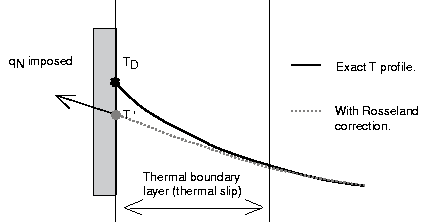In order to understand the modification of thermal boundary conditions, consider
Figure 25.1: Effect of the Rosseland Correction Near a Wall, which
details the temperature profile near a wall. The Rosseland approximation is unable
to take into account the sudden modification of the temperature gradient at the
boundary, the so-called "radiation slip". This means that the boundary condition
can no longer be prescribed, although it is the physical
condition. The Rosseland correction along a part of the boundary replaces
with a flux boundary condition that leads to a wall temperature
equal to
. The difference between
and
is large enough to modify the amplitude of the thermoconvection
cells in the whole domain.
When a Rosseland boundary condition is selected, you will enter as the "imposed" temperature. The flux
is then calculated on the basis of the refraction index
, the average absorption
, the Fourier conductivity
(without the third-order correction for internal radiation), and
the relative emissivity of the wall
. The expression for
is a fourth-order polynomial function of the temperature
:
(25–3) |
with
(25–4) |
and
(25–5) |



